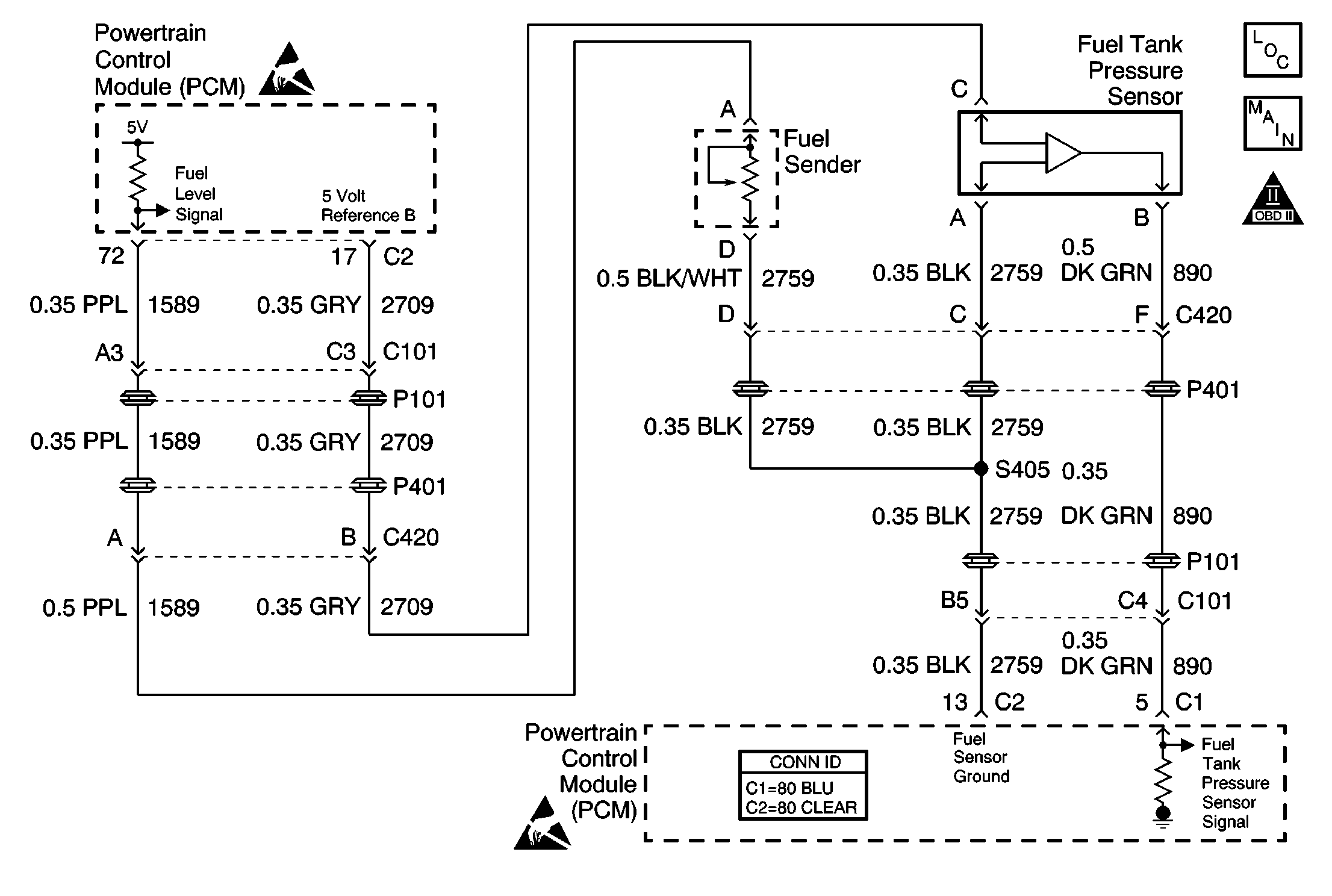
Circuit Description
The fuel tank pressure sensor measures the pressure (or vacuum) in the fuel tank. The PCM provides the sensor with a reference voltage, a signal circuit, and a ground. The sensor returns a signal voltage to the PCM relative to the pressure in the fuel tank. The PCM should see a signal voltage increase as the pressure in the tank decreases (more vacuum). As the pressure in the tank increases (less vacuum), the PCM should see a signal voltage decrease. The PCM uses the sensor signal to test the integrity of the EVAP system. If the PCM detects a signal voltage that is too high, DTC P0453 will set.
Conditions for Running the DTC
The ignition is ON.
Conditions for Setting the DTC
The fuel tank pressure sensor voltage is less than 4.9 volts for at least 1 second.
Action Taken When the DTC Sets
| • | The PCM will illuminate the malfunction indicator lamp (MIL) during the second consecutive trip in which the diagnostic test has been run and failed. |
| • | The PCM will store conditions which were present when the DTC set as Freeze Frame and Fail Records data. |
| • | The PCM will disable the EVAP system. |
Conditions for Clearing the MIL/DTC
| • | The PCM will turn the MIL OFF after the third consecutive trip in which the diagnostic runs and passes. |
| • | The history DTC will clear after 40 consecutive warm-up cycles have occurred without a malfunction. |
| • | The DTC can be cleared by using the scan tool Clear DTC Information function. |
Diagnostic Aids
Notice: Use the connector test adapter kit J 35616-A for any test that
requires probing the following items:
• The PCM harness connectors • The electrical center fuse/relay cavities • The component terminals • The component harness connector
Check for the following conditions:
| • | Poor connections at the PCM and the fuel tank pressure sensor--Inspect the harness connectors for backed out terminals, improper mating broken locks, improperly formed or damaged terminals, and poor terminal to wire connection. Refer to Testing for Intermittent Conditions and Poor Connections in Wiring Systems. |
| • | Damaged harness--Inspect the harness for damage. If the harness appears to be OK, observe the fuel tank pressure sensor display on the scan tool while moving connectors and wiring related to the sensor. A change in the display will indicate the location of the malfunction. |
Reviewing the Fail Records vehicle mileage since the diagnostic test last failed may assist in diagnosing the condition. The information may help determine how often the condition that set the DTC occurs.
Test Description
The numbers below refer to the step numbers on the diagnostic table.
-
Attempts to duplicate the condition.
-
This vehicle is equipped with a PCM which utilizes an electrically erasable programmable read only memory (EEPROM). When the PCM is replaced, the new PCM must be programmed.
Step | Action | Values | Yes | No | ||||
|---|---|---|---|---|---|---|---|---|
1 | Was the Powertrain On-Board Diagnostic (OBD) System Check performed? | -- | ||||||
2 | Is DTC P1639 also set? | -- | ||||||
3 |
Does the scan tool indicate a fuel tank pressure within the specified values? | Get values | ||||||
Does the scan tool indicate that DTC P0453 failed this ignition? | -- | Go to Diagnostic Aids | ||||||
5 |
Does the scan tool indicate a fuel tank pressure sensor voltage near the specified value? | 0 V | ||||||
6 |
Was a problem found? | -- | ||||||
7 | With the ignition switch ON, and the engine OFF, connect a DMM between battery positive voltage and the fuel tank pressure sensor ground circuit. Does the DMM indicate a voltage near the specified value? | B+ | ||||||
8 |
Was a problem found? | -- | ||||||
9 |
Was a problem found? | -- | ||||||
10 | Replace the fuel tank pressure sensor. Refer to Fuel Tank Pressure Sensor Replacement . Is action complete? | -- | -- | |||||
|
Important: The replacement PCM must be programmed. Replace the PCM. Refer to Powertrain Control Module Replacement/Programming . Is action complete? | -- | -- | ||||||
12 |
Does the scan tool indicate that DTC P0453 failed this ignition? | -- | System OK |
